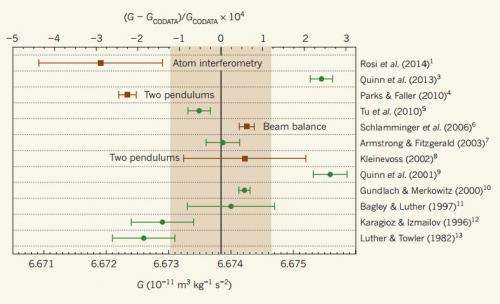June 19, 2014 report
Researchers use new method to calculate gravitational constant

(Phys.org) —A team of researchers in Europe has come up with a new way to determine the gravitational constant G. Rather than relying on using torque based techniques to measure gravitational pull, the researchers instead attempted to measure the attraction between a cloud of cold rubidium atoms and tungsten weights. They came up with a value for G of 6.67191(99) x 10−11 m3 kg−1 s−2. In their paper published in the journal Nature, the team describes their technique in great detail, and suggest it can be used to further refine a value for G. Stephan Schlamminger offers a News & Views piece describing the new technique and what it might mean, in the same journal issue.
It was Isaac Newton who first came up with the law describing how gravity pulls everything together, though he wasn't able to come up with an actual constant value. That was left to Henry Cavendish—he measured the torque that resulted from the gravitational attraction of weights attached to a rotating balance. Subsequent attempts have used roughly the same strategy with better precision. Unfortunately, as more precision is introduced the more differences researchers see in their results compared to what others find—there are just too many other attractive forces interfering. To overcome some of those problems, the researchers working on this new effort took an entirely new approach.
The team set up a cylinder containing tungsten weights surrounding a container that held a cloud of rubidium atoms. The apparatus was set up in such a way as to allow the researchers to pull the atoms up against Earth's gravity, or down to allow them to accelerate. The researchers used a laser light to split the cloud into two areas which were then pushed into a vacuum chamber. The two different cloud groups would rise to different heights before being pulled to the bottom of the chamber, creating an interference pattern—measurements of trajectory alterations in the interference pattern caused by the tungsten weights was used to determine G. The team ran measurements using multiple devices and with the weights in different positions to minimize noise from other sources.
Currently it's not clear if it's a good or bad thing that the new value for G differs from what others have found using traditional torque methods. Further research will help—the team notes that their technique offers promise of further refinement which could bring an even more precise value for G.
More information: Precision measurement of the Newtonian gravitational constant using cold atoms, Nature (2014) DOI: 10.1038/nature13433
Abstract
About 300 experiments have tried to determine the value of the Newtonian gravitational constant, G, so far, but large discrepancies in the results have made it impossible to know its value precisely. The weakness of the gravitational interaction and the impossibility of shielding the effects of gravity make it very difficult to measure G while keeping systematic effects under control. Most previous experiments performed were based on the torsion pendulum or torsion balance scheme as in the experiment by Cavendish in 1798, and in all cases macroscopic masses were used. Here we report the precise determination of G using laser-cooled atoms and quantum interferometry. We obtain the value G = 6.67191(99) × 10−11 m3 kg−1 s−2 with a relative uncertainty of 150 parts per million (the combined standard uncertainty is given in parentheses). Our value differs by 1.5 combined standard deviations from the current recommended value of the Committee on Data for Science and Technology. A conceptually different experiment such as ours helps to identify the systematic errors that have proved elusive in previous experiments, thus improving the confidence in the value of G. There is no definitive relationship between G and the other fundamental constants, and there is no theoretical prediction for its value, against which to test experimental results. Improving the precision with which we know G has not only a pure metrological interest, but is also important because of the key role that G has in theories of gravitation, cosmology, particle physics and astrophysics and in geophysical models.
Journal information: Nature
© 2014 Phys.org


















